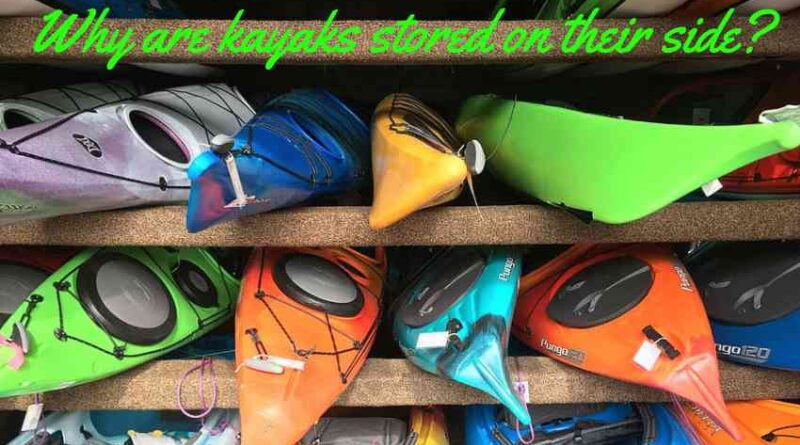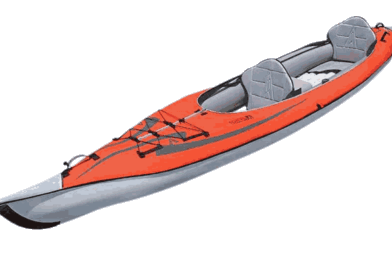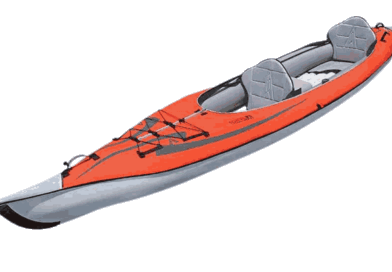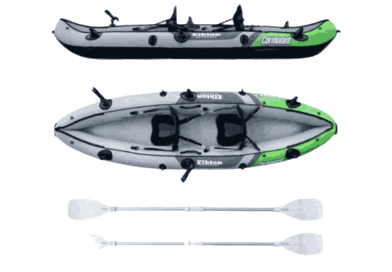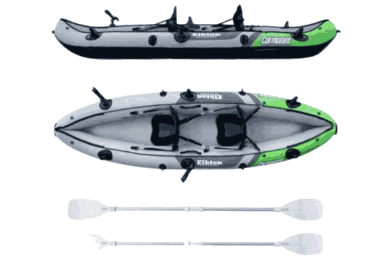Why are Kayaks Stored on Their Side? Answering FAQs
Kayak Storage Secrets Unveiled: Your Burning Questions Answered!
Attention all kayaking enthusiasts and adventure seekers! Are you ready to unlock the mysteries of proper kayak storage?
Look no further, for we have gathered the most crucial information to help you keep your beloved kayaks safe, secure, and ready for your next exhilarating paddling expedition.
In this article, we’ve delved deep into the world of kayak storage to answer your burning questions and reveal the secrets behind the best practices. From the age-old debate of vertical versus horizontal storage to the intriguing reasons behind kayaks being stored on their side, we’ve got you covered!
Table of Contents
What's the best way to store a kayak?
Imagine you’ve got a giant toy car – you wouldn’t want to leave it outside in the cold and rain, would you? So, your kayak needs a cozy home too.
A storage rack system is like a bed for your kayak and a covered porch or patio works like a little house. Wrap it up with a tarp or kayak cover (which acts like a warm blanket) but make sure the cover isn’t touching the kayak directly.
Now that we’ve talked about the best way to store your kayak, you might wonder which position is best – upright or lying flat? Let’s see in the next section!
Is it better to store a kayak vertically or horizontally?
You can think of storing a kayak like you would a big, tall book. If you’re not reading the book right now but want to keep it safe, you’d stand it up on a bookshelf, right? That’s like storing a kayak vertically, and it’s great for saving space and keeping it secure, especially inside your house or garage.
However, just like you wouldn’t want your book to fall and get damaged, make sure your kayak is safely secured if you store it vertically.
Now, let’s see why some people store kayaks on their side in the next section!
Why are kayaks stored on their side?
Think about your favorite pillow. If you sat on it for a long time, it could get squished and lose its shape, right? The same thing happens with kayaks. If they sit flat on their bottom part, called the hull, for too long, they can get dents.
So, just like you flip your pillow to keep it fluffy, kayaks should be stored on their side to keep them in the best shape. It’s like giving your kayak a comfy place to rest!
What about if you store a kayak on its pointy end, the stern? We’ll explore that in our next section, stay tuned!
Can you store a kayak on its stern?
Absolutely, storing a kayak on its stern (like its head) is doable! Just like you might stand a broom up on its bristles, you can store a kayak vertically against a wall. You’d need to protect its tip (the stern) with something soft, like how you’d use a helmet to protect your head when you go biking.
It’s also important to secure it well, so it doesn’t fall over.
We’ve talked about storing your kayak in different positions, but what about if you have a big 12-foot kayak? Let’s see next!
How do you store a 12 foot kayak?
Storing a 12-foot kayak is like handling a big, tall Christmas tree. Imagine standing the tree up in your living room, but at a slight angle so it doesn’t topple over. That’s how you should store your 12-foot kayak – vertically, with its back end (stern) on the ground and its front end (bow) up high.
Could you use sawhorses, like those used for woodworking, to store kayaks? Read on to find out!
Can you store kayaks on sawhorses?
Picture a big, strong horse carrying your favorite toy on its back. Now, imagine that horse as a sawhorse carrying your kayak. Sawhorses are very adaptable and can support nearly any size of kayak. It’s like a multi-purpose table that can hold anything you put on it!
So, just like you trust your horse to carry you, you can trust a sawhorse to safely store your kayak.
Curious about if you can stack kayaks like pancakes? Let’s delve into that in the next section!
Is it OK to stack kayaks on top of each other?
You can stack kayaks just like you stack your favorite books, but remember not to squeeze them together too tightly. It’s like if you squish a sandwich too hard, and the fillings squirt out – no fun, right? So, when you stack your kayaks, give them some room for air to circulate and don’t tie them too tightly together.
Let’s say you don’t have a good place at home to store your kayak. Could a marina, a place where boats hang out, help you? Let’s see!
Can I store my kayak at a marina?
Storing your kayak at a marina is like leaving your bike at a friend’s house. Some marinas let you rent space to keep your kayak, just like a bike rack at your friend’s place. And the cool part? You might get help launching your kayak, just like your friend helping you climb on your bike.
It’s a great option if you don’t have enough space at home.
You might have noticed some Styrofoam in your kayak. Should you leave it there? Find out next!
Do you keep Styrofoam in kayak?
Yes, the Styrofoam in your kayak is like the airbags in a car. They help the kayak float and keep its shape. If your kayak gets damaged while you’re having fun on the water, the Styrofoam could keep you safe, just like an airbag in a car accident. So, always keep the Styrofoam in your kayak!
How long do you think a kayak can last? Let’s find out in our next section!
How long do kayaks last?
Imagine your favorite toy car. If you take good care of it, it can last for years, right? It’s the same with a kayak. If you store and maintain it properly, a kayak can last for ten years or more, just like a treasured toy. But remember, the sun can damage the kayak over time, just like it can fade your toy car’s color.
So, always store your kayak properly.
You might have wondered – if a kayak flips over, could it sink? Let’s find out!
Do kayaks sink when flipped?
Kayaks can sink when they flip over, just like a toy boat in a bathtub. If lots of water gets inside the kayak, it might sink. This can happen more easily with sit-in kayaks because they have an open part where water can get in. So, always wear a life jacket and know what to do if you flip over!
Next, let’s figure out how cold is too cold for kayaking!
How cold is too cold for kayaking?
Think about when you go swimming. If the water’s too cold, it can be dangerous, right? It’s the same with kayaking. According to the American Canoe Association, water temperatures below 70°F (21.5°C) are considered too cold for kayaking without a wetsuit or drysuit. If the water temperature is below 70°F, you should be careful.
Cold Water Boot Camp, a program by the National Center for Cold Water Safety, advises against kayaking when water temperatures are below 50°F (10°C).
Cold water can make it hard to breathe and think clearly. So always check the water temperature before you go kayaking!
But, what’s the absolute coldest temperature for kayaking? Let’s find out!
What is the coldest temperature to kayak?
According to American Canoe Association (ACA), anything below 70°F is generally too cold to kayak, just like how ice cream would melt too fast on a hot day. If it’s colder than that, you should take extra precautions. Remember, being safe is always the most fun!
Finally, let’s talk about the ‘cold water rule’ for kayaks. Ready? Let’s go!
What is the cold water rule for kayaks?
Imagine swimming in a pool. If the water’s too cold, it can be dangerous, right? It’s the same with kayaking. Most people who get into trouble while kayaking are in water below 65°F. It’s like swimming in a really cold pool – it can be really dangerous!
So if the water is colder than 65°F, you should wear special clothes to stay safe.
(Source: American Canoeing Association)
Now you know all about how to store and take care of your kayak and when it’s safe to kayak. Remember, safety first, and then have fun!
Thanks for reading! We hope this guide has helped answer any questions you may have had about storing your kayak. Remember to always follow proper storage techniques to ensure your kayak stays in good condition for years to come. Happy paddling!
Frequently Asked Questions:
What is the best way to store a kayak to ensure its longevity and prevent damage?
The best way to store a kayak is by keeping it off the ground, protected from the elements, and in a stable position.
Can you explain the advantages and disadvantages of storing a kayak vertically versus horizontally?
Advantages of storing a kayak vertically include saving space and preventing warping. However, it may require additional support to prevent it from falling over.
Why do many kayak owners choose to store their kayaks on their side rather than in other positions?
Many kayak owners choose to store their kayaks on their side to save space and prevent deformation.
Is it safe and recommended to store a kayak on its stern or should it always be stored on its side?
It is generally safe and recommended to store a kayak on its side rather than on its stern.
What are some practical tips or techniques for properly storing a 12-foot kayak to save space and maintain its condition?
To properly store a 12-foot kayak and save space, you can use wall-mounted brackets, ceiling hoists, or kayak stands. Covering it with a tarp or storing it indoors can help maintain its condition.
What can you do now?
Based on the information provided, the best way to store a kayak is vertically on its side. You can use a rack or wall mount specifically designed for kayaks to ensure proper support and prevent damage. It is not recommended to store a kayak on its stern or stack multiple kayaks on top of each other.
If you are looking for a reliable and durable kayak, you may want to consider checking out the 12 best kayaks on the market. These products have been carefully selected and reviewed to help you make an informed decision. With the right storage and maintenance, a quality kayak can last for many years of enjoyable paddling.
Now that you’ve learned some valuable information about storing kayaks and keeping them in good condition, let’s dive into a whole new set of topics in the next article. This article explores various accessories and maintenance tips for your kayak. From the usefulness of kayak outriggers to the effectiveness of different types of tape, we’ll explore how to protect and enhance your kayaking experience.
So, let’s switch gears and embark on an exciting journey through the world of kayak accessories and maintenance in the next article!
